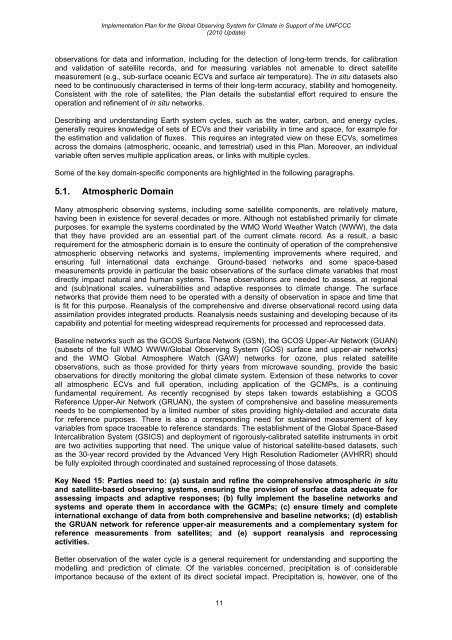GCOS Implementation Plan - WMO
GCOS Implementation Plan - WMO
GCOS Implementation Plan - WMO
You also want an ePaper? Increase the reach of your titles
YUMPU automatically turns print PDFs into web optimized ePapers that Google loves.
<strong>Implementation</strong> <strong>Plan</strong> for the Global Observing System for Climate in Support of the UNFCCC<br />
(2010 Update)<br />
observations for data and information, including for the detection of long-term trends, for calibration<br />
and validation of satellite records, and for measuring variables not amenable to direct satellite<br />
measurement (e.g., sub-surface oceanic ECVs and surface air temperature). The in situ datasets also<br />
need to be continuously characterised in terms of their long-term accuracy, stability and homogeneity.<br />
Consistent with the role of satellites, the <strong>Plan</strong> details the substantial effort required to ensure the<br />
operation and refinement of in situ networks.<br />
Describing and understanding Earth system cycles, such as the water, carbon, and energy cycles,<br />
generally requires knowledge of sets of ECVs and their variability in time and space, for example for<br />
the estimation and validation of fluxes. This requires an integrated view on these ECVs, sometimes<br />
across the domains (atmospheric, oceanic, and terrestrial) used in this <strong>Plan</strong>. Moreover, an individual<br />
variable often serves multiple application areas, or links with multiple cycles.<br />
Some of the key domain-specific components are highlighted in the following paragraphs.<br />
5.1. Atmospheric Domain<br />
Many atmospheric observing systems, including some satellite components, are relatively mature,<br />
having been in existence for several decades or more. Although not established primarily for climate<br />
purposes, for example the systems coordinated by the <strong>WMO</strong> World Weather Watch (WWW), the data<br />
that they have provided are an essential part of the current climate record. As a result, a basic<br />
requirement for the atmospheric domain is to ensure the continuity of operation of the comprehensive<br />
atmospheric observing networks and systems, implementing improvements where required, and<br />
ensuring full international data exchange. Ground-based networks and some space-based<br />
measurements provide in particular the basic observations of the surface climate variables that most<br />
directly impact natural and human systems. These observations are needed to assess, at regional<br />
and (sub)national scales, vulnerabilities and adaptive responses to climate change. The surface<br />
networks that provide them need to be operated with a density of observation in space and time that<br />
is fit for this purpose. Reanalysis of the comprehensive and diverse observational record using data<br />
assimilation provides integrated products. Reanalysis needs sustaining and developing because of its<br />
capability and potential for meeting widespread requirements for processed and reprocessed data.<br />
Baseline networks such as the <strong>GCOS</strong> Surface Network (GSN), the <strong>GCOS</strong> Upper-Air Network (GUAN)<br />
(subsets of the full <strong>WMO</strong> WWW/Global Observing System (GOS) surface and upper-air networks)<br />
and the <strong>WMO</strong> Global Atmosphere Watch (GAW) networks for ozone, plus related satellite<br />
observations, such as those provided for thirty years from microwave sounding, provide the basic<br />
observations for directly monitoring the global climate system. Extension of these networks to cover<br />
all atmospheric ECVs and full operation, including application of the GCMPs, is a continuing<br />
fundamental requirement. As recently recognised by steps taken towards establishing a <strong>GCOS</strong><br />
Reference Upper-Air Network (GRUAN), the system of comprehensive and baseline measurements<br />
needs to be complemented by a limited number of sites providing highly-detailed and accurate data<br />
for reference purposes. There is also a corresponding need for sustained measurement of key<br />
variables from space traceable to reference standards. The establishment of the Global Space-Based<br />
Intercalibration System (GSICS) and deployment of rigorously-calibrated satellite instruments in orbit<br />
are two activities supporting that need. The unique value of historical satellite-based datasets, such<br />
as the 30-year record provided by the Advanced Very High Resolution Radiometer (AVHRR) should<br />
be fully exploited through coordinated and sustained reprocessing of those datasets.<br />
Key Need 15: Parties need to: (a) sustain and refine the comprehensive atmospheric in situ<br />
and satellite-based observing systems, ensuring the provision of surface data adequate for<br />
assessing impacts and adaptive responses; (b) fully implement the baseline networks and<br />
systems and operate them in accordance with the GCMPs; (c) ensure timely and complete<br />
international exchange of data from both comprehensive and baseline networks; (d) establish<br />
the GRUAN network for reference upper-air measurements and a complementary system for<br />
reference measurements from satellites; and (e) support reanalysis and reprocessing<br />
activities.<br />
Better observation of the water cycle is a general requirement for understanding and supporting the<br />
modelling and prediction of climate. Of the variables concerned, precipitation is of considerable<br />
importance because of the extent of its direct societal impact. Precipitation is, however, one of the<br />
11
















